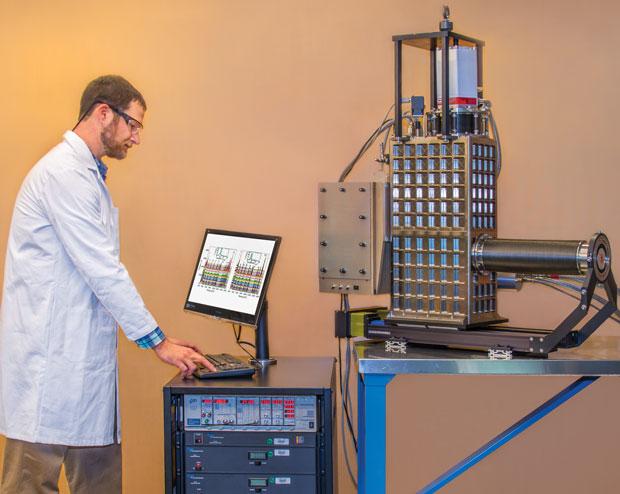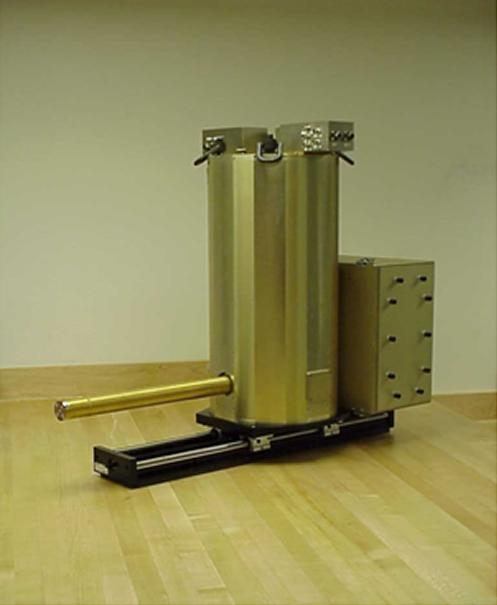Cryogenic detectors have been under development as energy dispersive X-ray detectors with high energy resolution for over a decade. Cryogenic detectors rely on measuring low-energy solid-state excitations as part of their detection mechanism, and therefore must be operated at temperatures typically below 1K to avoid excess thermal excitations. While the energy resolution for X-rays achieved with cryogenic detectors is an order of magnitude better than for conventional, ionization-based semiconductor detectors, most of the cryogenic detectors developed thus far suffer from slow speed.
LLNL's X-ray spectrometers based on STJ have been developed for high-resolution soft X-ray spectroscopy. STJ consist of two superconducting thin film electrodes separated by a thin insulating tunnel barrier. They measure X-ray energies from the increase in tunneling current after X-ray absorption in one of the electrodes excites additional charge carriers above the superconducting energy gap. STJ have an energy resolution an order of magnitude higher than conventional energy-dispersive X-ray detectors based on germanium or silicon semiconductors. The short life time of X-ray-induced excess charges allows detector operation at count rates up to 10,000 counts/per detector pixel. Effective area and total count rate capabilities have been increased by developing detector arrays.
For additional technical information, refer to published articles:
"The superconducting high-resolution soft X-ray spectrometer at the advanced biological and environmental X-ray facility" Nuclear Instruments and Methods in Physics Research A 582 (2007) 187-189
"Energy resolution and high count rate performance of superconducting tunnel junction x-ray spectrometers" American Institute of Physics Rev. Sci. Instrum. 69 .1., January 1998
The high energy resolution combined with the high count rate capabilities and high quantum efficiency of STJ detectors greatly enhance the sensitivity of non-destructive analysis by X-ray spectroscopy at electron and photon sources whenever conventional semiconductor detectors lack energy resolution and grating spectrometers lack detection efficiency. This includes energy-dispersive spectroscopy at scanning-electron or X-ray microscopes for defect analysis of small particles on semiconductor wafers. It also includes fluorescence-detected X-ray absorption spectroscopy for chemical state analysis of dilute specimens at synchrotron light sources.
Compared to other superconducting detector technologies that require operating temperatures of approximately 0.1K and costly superconducting quantum interference device (SQUID) preamplifiers, STJ detectors can be operated at temperatures up to approximately 0.5K and be read out with simple FET preamplifiers at room temperature. This reduces price and improves reliability.
There is a wide range of applications for energy-dispersive, high-resolution X-ray spectrometers with high count rate capability. These applications include:
- semiconductor industry material analysis by X-ray fluorescence analysis
- total reflection X-ray fluorescence analysis or microanalysis in combination with a scanning electron microscope
- high-resolution fluorescence-detected X-ray absorption spectroscopy at synchrotron light sources for material and life science
- plasma diagnostics
- EUV and X-ray astrophysics and beta-particle spectroscopy
With larger STJ detector arrays, future commercial and scientific applications may include:
- medical X-Ray imaging
- X-ray, UV and optical imaging in astrophysics
Several high-resolution STJ spectrometers have been built and operated successfully since 1999. A prototype commercial instrument is currently being tested that uses a mechanical cryocooler for precooling to 4K and attains the required base temperature without the use of liquid cryogens.
U.S. Patent 6,528,814.



